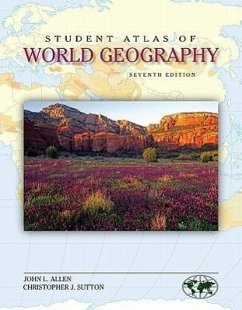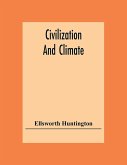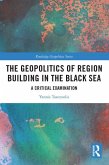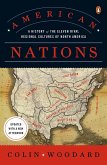Schade – dieser Artikel ist leider ausverkauft. Sobald wir wissen, ob und wann der Artikel wieder verfügbar ist, informieren wir Sie an dieser Stelle.
- Broschiertes Buch
- Merkliste
- Auf die Merkliste
- Bewerten Bewerten
- Teilen
- Produkt teilen
- Produkterinnerung
- Produkterinnerung
The Student Atlas series combines full-color maps and data sets to introduce students to the importance of the connections between geography and other areas of study such as world politics, environmental issues, and economic development. These thematic atlases will give students a clear picture of the recent agricultural, industrial, demographic, environmental, economic, and political changes in every world region.
Andere Kunden interessierten sich auch für
![Land Land]() Simon WinchesterLand26,99 €
Simon WinchesterLand26,99 €![Civilization And Climate Civilization And Climate]() Ellsworth HuntingtonCivilization And Climate35,99 €
Ellsworth HuntingtonCivilization And Climate35,99 €![The Geopolitics of Region Building in the Black Sea The Geopolitics of Region Building in the Black Sea]() Yannis TsantoulisThe Geopolitics of Region Building in the Black Sea60,99 €
Yannis TsantoulisThe Geopolitics of Region Building in the Black Sea60,99 €![Earth, Cosmos and Culture Earth, Cosmos and Culture]() Oliver Tristan DunnettEarth, Cosmos and Culture60,99 €
Oliver Tristan DunnettEarth, Cosmos and Culture60,99 €![Geography and Genealogy Geography and Genealogy]() Jeanne Kay GuelkeGeography and Genealogy75,99 €
Jeanne Kay GuelkeGeography and Genealogy75,99 €![American Nations American Nations]() Colin WoodardAmerican Nations23,99 €
Colin WoodardAmerican Nations23,99 €![The Shock of the Anthropocene: The Earth, History and Us The Shock of the Anthropocene: The Earth, History and Us]() Christophe BonneuilThe Shock of the Anthropocene: The Earth, History and Us16,99 €
Christophe BonneuilThe Shock of the Anthropocene: The Earth, History and Us16,99 €
The Student Atlas series combines full-color maps and data sets to introduce students to the importance of the connections between geography and other areas of study such as world politics, environmental issues, and economic development. These thematic atlases will give students a clear picture of the recent agricultural, industrial, demographic, environmental, economic, and political changes in every world region.
Produktdetails
- Produktdetails
- Student Atlas
- Verlag: Dushkin Publishing
- Revised
- Seitenzahl: 288
- Erscheinungstermin: März 2011
- Englisch
- Abmessung: 272mm x 213mm x 13mm
- Gewicht: 576g
- ISBN-13: 9780073527628
- ISBN-10: 0073527629
- Artikelnr.: 31574187
- Herstellerkennzeichnung
- Libri GmbH
- Europaallee 1
- 36244 Bad Hersfeld
- gpsr@libri.de
- Student Atlas
- Verlag: Dushkin Publishing
- Revised
- Seitenzahl: 288
- Erscheinungstermin: März 2011
- Englisch
- Abmessung: 272mm x 213mm x 13mm
- Gewicht: 576g
- ISBN-13: 9780073527628
- ISBN-10: 0073527629
- Artikelnr.: 31574187
- Herstellerkennzeichnung
- Libri GmbH
- Europaallee 1
- 36244 Bad Hersfeld
- gpsr@libri.de
McGraw-Hill authors represent the leading experts in their fields and are dedicated to improving the lives, careers, and interests of readers worldwide
Table of Contents
A Note to the Student iii
Introduction: How to Read an Atlas xii
Unit I Global Physical Patterns 1
Map 1World Political Boundaries 2
Map 2World Physical Features 4
Map 3aAverage Annual Precipitation 6
Map 3bSeasonal Average Precipitation, November through April 7
Map 3cSeasonal Average Precipitation, May through October 7
Map 3dVariation in Average Annual Precipitation 8
Map 4aTemperature Regions and Ocean Currents 9
Map 4bAverage January Temperature 10
Map 4cAverage July Temperature 10
Map 5aAtmospheric Pressure and Predominant Surface Winds, January 11
Map 5bAtmospheric Pressure and Predominant Surface Winds, July 12
Map 6Climate Regions 13
Map 7Vegetation Types 14
Map 8Soil Orders 15
Map 9Ecological Regions 16
Map 10Plate Tectonics 18
Map 11Topography 19
Map 12aResources: Mineral Fuels 20
Map 12bResources: Critical Metals 21
Map 13Natural Hazards 22
Unit II Global Human Patterns 23
Map 14Past Population Distributions and Densities 24
Map 15Population Density 26
Map 16Land Use, a.d. 1500 27
Map 17Economic Activities 28
Map 18Urbanization 29
Map 19Transportation Patterns 30
Map 20Religions 31
Map 21Religious Adherence 32
Map 22Languages 33
Map 23Linguistic Diversity 34
Map 24Dying Languages: A Loss of Cultural Wealth 35
Map 25External Migrations in Modern Times 36
Unit III Global Demographic Patterns 37
Map 26Population Growth Rates 38
Map 27International Migrant Populations, 2009 39
Map 28Migration Rates 40
Map 29Europe's Population Bust: A Fizzle in the Population Bomb 41
Map 30aTotal Fertility Rates, 1975 42
Map 30bTotal Fertility Rates, 2010 43
Map 31Infant Mortality Rate 44
Map 32Child Mortality Rate 45
Map 33Population by Age Group 46
Map 34Average Life Expectancy at Birth 47
Map 35World Daily Per Capita Food Supply (Kilocalories) 48
Map 36The Earth's Hungry Millions 49
Map 37Child Malnutrition 50
Map 38Proportion of Daily Food Intake from Animal Products 51
Map 39The Global Security Threat of Infectious Diseases 52
Map 40Global Scourges: Major Infectious Diseases 54
Map 41Adult Incidence of HIV/AIDS, 2007 55
Map 42Illiteracy Rates 56
Map 43Primary School Enrollment 57
Map 44Female/Male Inequality in Education and Employment 58
Map 45The Index of Human Development 59
Map 46Demographic Stress: The Youth Bulge 60
Map 47Demographic Stress: Rapid Urban Growth 61
Map 48Demographic Stress: Competition for Cropland 62
Map 49Demographic Stress: Competition for Fresh Water 63
Map 50Demographic Stress: Death in the Prime of Life 64
Map 51Demographic Stress: Interactions of Demographic Stress Factors 65
Unit IV Global Economic Patterns 67
Map 52Gross National Income 68
Map 53Gross National Income Per Capita 69
Map 54Purchasing Power Parity Per Capita 70
Map 55Private Per Capita Consumption 71
Map 56Inequality of Income and Consumption 72
Map 57Total Labor Force 73
Map 58Employment by Economic Activity 74
Map 59Economic Output Per Sector 75
Map 60Agricultural Production Per Capita 76
Map 61Exports of Primary Products 77
Map 62Remittances 78
Map 63Membership in the World Trade Organization 79
Map 64Regional Trade Organizations 80
Map 65Dependence on Trade 81
Map 66Trade with Neighboring Countries 82
Map 67The Indebtedness of States 83
Map 68Global Flows of Investment Capital 84
Map 69Aiding Economic Development 85
Map 70The Cost of Consumption 86
Map 71Energy Production Per Capita 87
Map 72Energy Consumption Per Capita 88
Map 73Energy Dependency 89
Map 74Flows of Oil 90
Map 75A Wired World: Internet Users 91
Map 76Personal Computer Use 92
Map 77Traditional Links: The Telephone 93
Unit V Global Patterns of Environmental Disturbance 95
Map 78Global Air Pollution: Sources and Wind Currents 97
Map 79The Acid Deposition Problem: Air, Water, Soil 98
Map 80Major Polluters and Common Pollutants 99
Map 81Global Carbon Dioxide Emissions 100
Map 82The Earth Warms, 1976-2006 101
Map 83Global Precipitation Changes, 1976-2006 102
Map 84Potential Global Temperature Change 103
Map 85Water Resources: Availability of Renewable Water Per Capita 104
Map 86Water Resources: Annual Withdrawal Per Capita 105
Map 87Water Stress: Shortage, Abundance, and Population Density 106
Map 88Water Stress: The Ogallala Aquifer 107
Map 89A New Environmental Stress? Consumption of Bottled Water 108
Map 90Pollution of the Oceans 109
Map 91Food Supply from Marine and Freshwater Systems 110
Map 92Cropland Per Capita: Changes, 1996-2007 111
Map 93Food Staples Under Stress: The Fight Against Genetic Simplicity 112
Map 94World Pastureland, 2005 113
Map 95Fertilizer Use, 2007 114
Map 96Annual Deforestation Rates, 2000-2005 115
Map 97World Timber Production, 2005 116
Map 98The Loss of Biodiversity: Globally Threatened Animal Species, 2007
117
Map 99Disappearing Giants: The Reduction in "Conservative" Species 118
Map 100The Loss of Biodiversity: Globally Threatened Plant Species, 2007
120
Map 101The Areas of Greatest Loss and Hotspots of Biodiversity 121
Map 102Nationally Protected Areas: Parks and Preserves 122
Map 103The Risks of Desertification 123
Map 104Global Soil Degradation 124
Map 105The Degree of Human Disturbance 125
Map 106The Green and Not So Green World 126
Unit VI Global Political Patterns 127
Map 107Political Systems 129
Map 108The Emergence of the State 130
Map 109Organized States and Chiefdoms, a.d. 1500 131
Map 110European Colonialism, 1500-2000 132
Map 111Sovereign States: Duration of Independence 133
Map 112Post-Cold War International Alliances 134
Map 113Political Realms: Regional Changes, 1945-2003 135
Map 114International Conflicts in the Post-World War II World 136
Map 115The Geopolitical World in the Twenty-First Century 138
Map 116The United Nations 139
Map 117Is It a Country? 140
Map 118United Nations Regions and Sub-Regions 141
Map 119Democracy on the Rise 142
Map 120Nations with Nuclear Weapons 143
Map 121Military Expenditures as a Percentage of Gross National Product 144
Map 122Distribution of Minority Populations 145
Map 123Marginalized Minorities: Declining Indigenous Populations 146
Map 124The Political Geography of a Global Religion: The Islamic World 147
Map 125World Refugees: Country of Origin, 2009 148
Map 126World Refugees: Host Country, 2009 149
Map 127Internally Displaced Persons, 2009 150
Map 128Abuse of Public Trust 151
Map 129Political and Civil Liberties, 2008 152
Map 130Human Rights Abuse 153
Map 131Women's Rights 154
Map 132aFlashpoints, 2011-Mexico 155
Map 132bFlashpoints, 2011-Sudan and the Darfur Region 156
Map 132cFlashpoints, 2011-Somalia 156
Map 132dFlashpoints, 2011-Dem. Rep. Congo 157
Map 132eFlashpoints, 2011-Zimbabwe 157
Map 132fFlashpoints, 2011-Georgia 158
Map 132gFlashpoints, 2011-Kyrgyzstan 158
Map 132hFlashpoints, 2011-Israel and Its Neighbors 159
Map 132iFlashpoints, 2011-Iraq 159
Map 132jFlashpoints, 2011-Kurdistan 160
Map 132kFlashpoints, 2011-Iran 160
Map 132lFlashpoints, 2011-Afghanistan 161
Map 132mFlashpoints, 2011-Pakistan 161
Map 132nFlashpoints, 2011-Jammu and Kashmir 162
Map 132oFlashpoints, 2011-Sri Lanka 162
Map 132pFlashpoints, 2011-Korean Peninsula 163
Map 132qFlashpoints, 2011-Thailand 163
Unit VII World Regions 165
Map 133North America: Political Divisions 167
Map 134North America: Physical Features 168
Map 135aNorth America: Environment and Economy 169
Map 135bNorth America: Population Density 170
Map 135cNorth America: Population Distribution 170
Map 136Canada 171
Map 137United States 172
Map 138Middle America 173
Map 139The Caribbean 174
Map 140South America: Political Divisions 175
Map 141South America: Physical Features 176
Map 142aSouth America: Environment and Economy 177
Map 142bSouth America: Population Density 178
Map 142cSouth America: Environmental Problems 178
Map 143Northern South America 179
Map 144Southern South America 180
Map 145Europe: Political Divisions 181
Map 146Europe: Physical Features 182
Map 147aEurope: Environment and Economy 183
Map 147bEurope: Population Density 184
Map 147cEuropean Political Boundaries, 1914-1948 185
Map 147dEurope: Political Changes, 1989-2009 187
Map 148Western Europe 188
Map 149Eastern Europe 189
Map 150Northern Europe 190
Map 151Africa: Political Divisions 191
Map 152Africa: Physical Features 192
Map 153aAfrica: Environment and Economy 193
Map 153bAfrica: Population Density 193
Map 153cAfrica: Colonialism to Independence 194
Map 153dAfrican Cropland and Dryland Degradation 195
Map 154Northern Africa 196
Map 155Southern Africa 197
Map 156Asia: Political Divisions 198
Map 157Asia: Physical Features 199
Map 158aAsia: Environment and Economy 200
Map 158bAsia: Population Density 201
Map 158cAsia: Industrialization: Manu facturing and Resources 201
Map 159Northern Asia 202
Map 160Southwestern Asia 203
Map 161South Asia 204
Map 162East Asia 205
Map 163Southeast Asia 206
Map 164Australasia and Western Oceania: Political Divisions 207
Map 165Oceania: Political Divisions 208
Map 166Australasia and Western Oceania: Physical Features 209
Map 167aAustralasia: Environment and Economy 210
Map 167bAustralasia: Population Density 211
Map 167cAustralasia: Climatic Patterns 211
Map 168The Arctic 212
Map 169Antarctica 212
Unit VIII Country and Dependency Profiles 213 Unit IX Geographic Index 243
Sources 263
A Note to the Student iii
Introduction: How to Read an Atlas xii
Unit I Global Physical Patterns 1
Map 1World Political Boundaries 2
Map 2World Physical Features 4
Map 3aAverage Annual Precipitation 6
Map 3bSeasonal Average Precipitation, November through April 7
Map 3cSeasonal Average Precipitation, May through October 7
Map 3dVariation in Average Annual Precipitation 8
Map 4aTemperature Regions and Ocean Currents 9
Map 4bAverage January Temperature 10
Map 4cAverage July Temperature 10
Map 5aAtmospheric Pressure and Predominant Surface Winds, January 11
Map 5bAtmospheric Pressure and Predominant Surface Winds, July 12
Map 6Climate Regions 13
Map 7Vegetation Types 14
Map 8Soil Orders 15
Map 9Ecological Regions 16
Map 10Plate Tectonics 18
Map 11Topography 19
Map 12aResources: Mineral Fuels 20
Map 12bResources: Critical Metals 21
Map 13Natural Hazards 22
Unit II Global Human Patterns 23
Map 14Past Population Distributions and Densities 24
Map 15Population Density 26
Map 16Land Use, a.d. 1500 27
Map 17Economic Activities 28
Map 18Urbanization 29
Map 19Transportation Patterns 30
Map 20Religions 31
Map 21Religious Adherence 32
Map 22Languages 33
Map 23Linguistic Diversity 34
Map 24Dying Languages: A Loss of Cultural Wealth 35
Map 25External Migrations in Modern Times 36
Unit III Global Demographic Patterns 37
Map 26Population Growth Rates 38
Map 27International Migrant Populations, 2009 39
Map 28Migration Rates 40
Map 29Europe's Population Bust: A Fizzle in the Population Bomb 41
Map 30aTotal Fertility Rates, 1975 42
Map 30bTotal Fertility Rates, 2010 43
Map 31Infant Mortality Rate 44
Map 32Child Mortality Rate 45
Map 33Population by Age Group 46
Map 34Average Life Expectancy at Birth 47
Map 35World Daily Per Capita Food Supply (Kilocalories) 48
Map 36The Earth's Hungry Millions 49
Map 37Child Malnutrition 50
Map 38Proportion of Daily Food Intake from Animal Products 51
Map 39The Global Security Threat of Infectious Diseases 52
Map 40Global Scourges: Major Infectious Diseases 54
Map 41Adult Incidence of HIV/AIDS, 2007 55
Map 42Illiteracy Rates 56
Map 43Primary School Enrollment 57
Map 44Female/Male Inequality in Education and Employment 58
Map 45The Index of Human Development 59
Map 46Demographic Stress: The Youth Bulge 60
Map 47Demographic Stress: Rapid Urban Growth 61
Map 48Demographic Stress: Competition for Cropland 62
Map 49Demographic Stress: Competition for Fresh Water 63
Map 50Demographic Stress: Death in the Prime of Life 64
Map 51Demographic Stress: Interactions of Demographic Stress Factors 65
Unit IV Global Economic Patterns 67
Map 52Gross National Income 68
Map 53Gross National Income Per Capita 69
Map 54Purchasing Power Parity Per Capita 70
Map 55Private Per Capita Consumption 71
Map 56Inequality of Income and Consumption 72
Map 57Total Labor Force 73
Map 58Employment by Economic Activity 74
Map 59Economic Output Per Sector 75
Map 60Agricultural Production Per Capita 76
Map 61Exports of Primary Products 77
Map 62Remittances 78
Map 63Membership in the World Trade Organization 79
Map 64Regional Trade Organizations 80
Map 65Dependence on Trade 81
Map 66Trade with Neighboring Countries 82
Map 67The Indebtedness of States 83
Map 68Global Flows of Investment Capital 84
Map 69Aiding Economic Development 85
Map 70The Cost of Consumption 86
Map 71Energy Production Per Capita 87
Map 72Energy Consumption Per Capita 88
Map 73Energy Dependency 89
Map 74Flows of Oil 90
Map 75A Wired World: Internet Users 91
Map 76Personal Computer Use 92
Map 77Traditional Links: The Telephone 93
Unit V Global Patterns of Environmental Disturbance 95
Map 78Global Air Pollution: Sources and Wind Currents 97
Map 79The Acid Deposition Problem: Air, Water, Soil 98
Map 80Major Polluters and Common Pollutants 99
Map 81Global Carbon Dioxide Emissions 100
Map 82The Earth Warms, 1976-2006 101
Map 83Global Precipitation Changes, 1976-2006 102
Map 84Potential Global Temperature Change 103
Map 85Water Resources: Availability of Renewable Water Per Capita 104
Map 86Water Resources: Annual Withdrawal Per Capita 105
Map 87Water Stress: Shortage, Abundance, and Population Density 106
Map 88Water Stress: The Ogallala Aquifer 107
Map 89A New Environmental Stress? Consumption of Bottled Water 108
Map 90Pollution of the Oceans 109
Map 91Food Supply from Marine and Freshwater Systems 110
Map 92Cropland Per Capita: Changes, 1996-2007 111
Map 93Food Staples Under Stress: The Fight Against Genetic Simplicity 112
Map 94World Pastureland, 2005 113
Map 95Fertilizer Use, 2007 114
Map 96Annual Deforestation Rates, 2000-2005 115
Map 97World Timber Production, 2005 116
Map 98The Loss of Biodiversity: Globally Threatened Animal Species, 2007
117
Map 99Disappearing Giants: The Reduction in "Conservative" Species 118
Map 100The Loss of Biodiversity: Globally Threatened Plant Species, 2007
120
Map 101The Areas of Greatest Loss and Hotspots of Biodiversity 121
Map 102Nationally Protected Areas: Parks and Preserves 122
Map 103The Risks of Desertification 123
Map 104Global Soil Degradation 124
Map 105The Degree of Human Disturbance 125
Map 106The Green and Not So Green World 126
Unit VI Global Political Patterns 127
Map 107Political Systems 129
Map 108The Emergence of the State 130
Map 109Organized States and Chiefdoms, a.d. 1500 131
Map 110European Colonialism, 1500-2000 132
Map 111Sovereign States: Duration of Independence 133
Map 112Post-Cold War International Alliances 134
Map 113Political Realms: Regional Changes, 1945-2003 135
Map 114International Conflicts in the Post-World War II World 136
Map 115The Geopolitical World in the Twenty-First Century 138
Map 116The United Nations 139
Map 117Is It a Country? 140
Map 118United Nations Regions and Sub-Regions 141
Map 119Democracy on the Rise 142
Map 120Nations with Nuclear Weapons 143
Map 121Military Expenditures as a Percentage of Gross National Product 144
Map 122Distribution of Minority Populations 145
Map 123Marginalized Minorities: Declining Indigenous Populations 146
Map 124The Political Geography of a Global Religion: The Islamic World 147
Map 125World Refugees: Country of Origin, 2009 148
Map 126World Refugees: Host Country, 2009 149
Map 127Internally Displaced Persons, 2009 150
Map 128Abuse of Public Trust 151
Map 129Political and Civil Liberties, 2008 152
Map 130Human Rights Abuse 153
Map 131Women's Rights 154
Map 132aFlashpoints, 2011-Mexico 155
Map 132bFlashpoints, 2011-Sudan and the Darfur Region 156
Map 132cFlashpoints, 2011-Somalia 156
Map 132dFlashpoints, 2011-Dem. Rep. Congo 157
Map 132eFlashpoints, 2011-Zimbabwe 157
Map 132fFlashpoints, 2011-Georgia 158
Map 132gFlashpoints, 2011-Kyrgyzstan 158
Map 132hFlashpoints, 2011-Israel and Its Neighbors 159
Map 132iFlashpoints, 2011-Iraq 159
Map 132jFlashpoints, 2011-Kurdistan 160
Map 132kFlashpoints, 2011-Iran 160
Map 132lFlashpoints, 2011-Afghanistan 161
Map 132mFlashpoints, 2011-Pakistan 161
Map 132nFlashpoints, 2011-Jammu and Kashmir 162
Map 132oFlashpoints, 2011-Sri Lanka 162
Map 132pFlashpoints, 2011-Korean Peninsula 163
Map 132qFlashpoints, 2011-Thailand 163
Unit VII World Regions 165
Map 133North America: Political Divisions 167
Map 134North America: Physical Features 168
Map 135aNorth America: Environment and Economy 169
Map 135bNorth America: Population Density 170
Map 135cNorth America: Population Distribution 170
Map 136Canada 171
Map 137United States 172
Map 138Middle America 173
Map 139The Caribbean 174
Map 140South America: Political Divisions 175
Map 141South America: Physical Features 176
Map 142aSouth America: Environment and Economy 177
Map 142bSouth America: Population Density 178
Map 142cSouth America: Environmental Problems 178
Map 143Northern South America 179
Map 144Southern South America 180
Map 145Europe: Political Divisions 181
Map 146Europe: Physical Features 182
Map 147aEurope: Environment and Economy 183
Map 147bEurope: Population Density 184
Map 147cEuropean Political Boundaries, 1914-1948 185
Map 147dEurope: Political Changes, 1989-2009 187
Map 148Western Europe 188
Map 149Eastern Europe 189
Map 150Northern Europe 190
Map 151Africa: Political Divisions 191
Map 152Africa: Physical Features 192
Map 153aAfrica: Environment and Economy 193
Map 153bAfrica: Population Density 193
Map 153cAfrica: Colonialism to Independence 194
Map 153dAfrican Cropland and Dryland Degradation 195
Map 154Northern Africa 196
Map 155Southern Africa 197
Map 156Asia: Political Divisions 198
Map 157Asia: Physical Features 199
Map 158aAsia: Environment and Economy 200
Map 158bAsia: Population Density 201
Map 158cAsia: Industrialization: Manu facturing and Resources 201
Map 159Northern Asia 202
Map 160Southwestern Asia 203
Map 161South Asia 204
Map 162East Asia 205
Map 163Southeast Asia 206
Map 164Australasia and Western Oceania: Political Divisions 207
Map 165Oceania: Political Divisions 208
Map 166Australasia and Western Oceania: Physical Features 209
Map 167aAustralasia: Environment and Economy 210
Map 167bAustralasia: Population Density 211
Map 167cAustralasia: Climatic Patterns 211
Map 168The Arctic 212
Map 169Antarctica 212
Unit VIII Country and Dependency Profiles 213 Unit IX Geographic Index 243
Sources 263
Table of Contents
A Note to the Student iii
Introduction: How to Read an Atlas xii
Unit I Global Physical Patterns 1
Map 1World Political Boundaries 2
Map 2World Physical Features 4
Map 3aAverage Annual Precipitation 6
Map 3bSeasonal Average Precipitation, November through April 7
Map 3cSeasonal Average Precipitation, May through October 7
Map 3dVariation in Average Annual Precipitation 8
Map 4aTemperature Regions and Ocean Currents 9
Map 4bAverage January Temperature 10
Map 4cAverage July Temperature 10
Map 5aAtmospheric Pressure and Predominant Surface Winds, January 11
Map 5bAtmospheric Pressure and Predominant Surface Winds, July 12
Map 6Climate Regions 13
Map 7Vegetation Types 14
Map 8Soil Orders 15
Map 9Ecological Regions 16
Map 10Plate Tectonics 18
Map 11Topography 19
Map 12aResources: Mineral Fuels 20
Map 12bResources: Critical Metals 21
Map 13Natural Hazards 22
Unit II Global Human Patterns 23
Map 14Past Population Distributions and Densities 24
Map 15Population Density 26
Map 16Land Use, a.d. 1500 27
Map 17Economic Activities 28
Map 18Urbanization 29
Map 19Transportation Patterns 30
Map 20Religions 31
Map 21Religious Adherence 32
Map 22Languages 33
Map 23Linguistic Diversity 34
Map 24Dying Languages: A Loss of Cultural Wealth 35
Map 25External Migrations in Modern Times 36
Unit III Global Demographic Patterns 37
Map 26Population Growth Rates 38
Map 27International Migrant Populations, 2009 39
Map 28Migration Rates 40
Map 29Europe's Population Bust: A Fizzle in the Population Bomb 41
Map 30aTotal Fertility Rates, 1975 42
Map 30bTotal Fertility Rates, 2010 43
Map 31Infant Mortality Rate 44
Map 32Child Mortality Rate 45
Map 33Population by Age Group 46
Map 34Average Life Expectancy at Birth 47
Map 35World Daily Per Capita Food Supply (Kilocalories) 48
Map 36The Earth's Hungry Millions 49
Map 37Child Malnutrition 50
Map 38Proportion of Daily Food Intake from Animal Products 51
Map 39The Global Security Threat of Infectious Diseases 52
Map 40Global Scourges: Major Infectious Diseases 54
Map 41Adult Incidence of HIV/AIDS, 2007 55
Map 42Illiteracy Rates 56
Map 43Primary School Enrollment 57
Map 44Female/Male Inequality in Education and Employment 58
Map 45The Index of Human Development 59
Map 46Demographic Stress: The Youth Bulge 60
Map 47Demographic Stress: Rapid Urban Growth 61
Map 48Demographic Stress: Competition for Cropland 62
Map 49Demographic Stress: Competition for Fresh Water 63
Map 50Demographic Stress: Death in the Prime of Life 64
Map 51Demographic Stress: Interactions of Demographic Stress Factors 65
Unit IV Global Economic Patterns 67
Map 52Gross National Income 68
Map 53Gross National Income Per Capita 69
Map 54Purchasing Power Parity Per Capita 70
Map 55Private Per Capita Consumption 71
Map 56Inequality of Income and Consumption 72
Map 57Total Labor Force 73
Map 58Employment by Economic Activity 74
Map 59Economic Output Per Sector 75
Map 60Agricultural Production Per Capita 76
Map 61Exports of Primary Products 77
Map 62Remittances 78
Map 63Membership in the World Trade Organization 79
Map 64Regional Trade Organizations 80
Map 65Dependence on Trade 81
Map 66Trade with Neighboring Countries 82
Map 67The Indebtedness of States 83
Map 68Global Flows of Investment Capital 84
Map 69Aiding Economic Development 85
Map 70The Cost of Consumption 86
Map 71Energy Production Per Capita 87
Map 72Energy Consumption Per Capita 88
Map 73Energy Dependency 89
Map 74Flows of Oil 90
Map 75A Wired World: Internet Users 91
Map 76Personal Computer Use 92
Map 77Traditional Links: The Telephone 93
Unit V Global Patterns of Environmental Disturbance 95
Map 78Global Air Pollution: Sources and Wind Currents 97
Map 79The Acid Deposition Problem: Air, Water, Soil 98
Map 80Major Polluters and Common Pollutants 99
Map 81Global Carbon Dioxide Emissions 100
Map 82The Earth Warms, 1976-2006 101
Map 83Global Precipitation Changes, 1976-2006 102
Map 84Potential Global Temperature Change 103
Map 85Water Resources: Availability of Renewable Water Per Capita 104
Map 86Water Resources: Annual Withdrawal Per Capita 105
Map 87Water Stress: Shortage, Abundance, and Population Density 106
Map 88Water Stress: The Ogallala Aquifer 107
Map 89A New Environmental Stress? Consumption of Bottled Water 108
Map 90Pollution of the Oceans 109
Map 91Food Supply from Marine and Freshwater Systems 110
Map 92Cropland Per Capita: Changes, 1996-2007 111
Map 93Food Staples Under Stress: The Fight Against Genetic Simplicity 112
Map 94World Pastureland, 2005 113
Map 95Fertilizer Use, 2007 114
Map 96Annual Deforestation Rates, 2000-2005 115
Map 97World Timber Production, 2005 116
Map 98The Loss of Biodiversity: Globally Threatened Animal Species, 2007
117
Map 99Disappearing Giants: The Reduction in "Conservative" Species 118
Map 100The Loss of Biodiversity: Globally Threatened Plant Species, 2007
120
Map 101The Areas of Greatest Loss and Hotspots of Biodiversity 121
Map 102Nationally Protected Areas: Parks and Preserves 122
Map 103The Risks of Desertification 123
Map 104Global Soil Degradation 124
Map 105The Degree of Human Disturbance 125
Map 106The Green and Not So Green World 126
Unit VI Global Political Patterns 127
Map 107Political Systems 129
Map 108The Emergence of the State 130
Map 109Organized States and Chiefdoms, a.d. 1500 131
Map 110European Colonialism, 1500-2000 132
Map 111Sovereign States: Duration of Independence 133
Map 112Post-Cold War International Alliances 134
Map 113Political Realms: Regional Changes, 1945-2003 135
Map 114International Conflicts in the Post-World War II World 136
Map 115The Geopolitical World in the Twenty-First Century 138
Map 116The United Nations 139
Map 117Is It a Country? 140
Map 118United Nations Regions and Sub-Regions 141
Map 119Democracy on the Rise 142
Map 120Nations with Nuclear Weapons 143
Map 121Military Expenditures as a Percentage of Gross National Product 144
Map 122Distribution of Minority Populations 145
Map 123Marginalized Minorities: Declining Indigenous Populations 146
Map 124The Political Geography of a Global Religion: The Islamic World 147
Map 125World Refugees: Country of Origin, 2009 148
Map 126World Refugees: Host Country, 2009 149
Map 127Internally Displaced Persons, 2009 150
Map 128Abuse of Public Trust 151
Map 129Political and Civil Liberties, 2008 152
Map 130Human Rights Abuse 153
Map 131Women's Rights 154
Map 132aFlashpoints, 2011-Mexico 155
Map 132bFlashpoints, 2011-Sudan and the Darfur Region 156
Map 132cFlashpoints, 2011-Somalia 156
Map 132dFlashpoints, 2011-Dem. Rep. Congo 157
Map 132eFlashpoints, 2011-Zimbabwe 157
Map 132fFlashpoints, 2011-Georgia 158
Map 132gFlashpoints, 2011-Kyrgyzstan 158
Map 132hFlashpoints, 2011-Israel and Its Neighbors 159
Map 132iFlashpoints, 2011-Iraq 159
Map 132jFlashpoints, 2011-Kurdistan 160
Map 132kFlashpoints, 2011-Iran 160
Map 132lFlashpoints, 2011-Afghanistan 161
Map 132mFlashpoints, 2011-Pakistan 161
Map 132nFlashpoints, 2011-Jammu and Kashmir 162
Map 132oFlashpoints, 2011-Sri Lanka 162
Map 132pFlashpoints, 2011-Korean Peninsula 163
Map 132qFlashpoints, 2011-Thailand 163
Unit VII World Regions 165
Map 133North America: Political Divisions 167
Map 134North America: Physical Features 168
Map 135aNorth America: Environment and Economy 169
Map 135bNorth America: Population Density 170
Map 135cNorth America: Population Distribution 170
Map 136Canada 171
Map 137United States 172
Map 138Middle America 173
Map 139The Caribbean 174
Map 140South America: Political Divisions 175
Map 141South America: Physical Features 176
Map 142aSouth America: Environment and Economy 177
Map 142bSouth America: Population Density 178
Map 142cSouth America: Environmental Problems 178
Map 143Northern South America 179
Map 144Southern South America 180
Map 145Europe: Political Divisions 181
Map 146Europe: Physical Features 182
Map 147aEurope: Environment and Economy 183
Map 147bEurope: Population Density 184
Map 147cEuropean Political Boundaries, 1914-1948 185
Map 147dEurope: Political Changes, 1989-2009 187
Map 148Western Europe 188
Map 149Eastern Europe 189
Map 150Northern Europe 190
Map 151Africa: Political Divisions 191
Map 152Africa: Physical Features 192
Map 153aAfrica: Environment and Economy 193
Map 153bAfrica: Population Density 193
Map 153cAfrica: Colonialism to Independence 194
Map 153dAfrican Cropland and Dryland Degradation 195
Map 154Northern Africa 196
Map 155Southern Africa 197
Map 156Asia: Political Divisions 198
Map 157Asia: Physical Features 199
Map 158aAsia: Environment and Economy 200
Map 158bAsia: Population Density 201
Map 158cAsia: Industrialization: Manu facturing and Resources 201
Map 159Northern Asia 202
Map 160Southwestern Asia 203
Map 161South Asia 204
Map 162East Asia 205
Map 163Southeast Asia 206
Map 164Australasia and Western Oceania: Political Divisions 207
Map 165Oceania: Political Divisions 208
Map 166Australasia and Western Oceania: Physical Features 209
Map 167aAustralasia: Environment and Economy 210
Map 167bAustralasia: Population Density 211
Map 167cAustralasia: Climatic Patterns 211
Map 168The Arctic 212
Map 169Antarctica 212
Unit VIII Country and Dependency Profiles 213 Unit IX Geographic Index 243
Sources 263
A Note to the Student iii
Introduction: How to Read an Atlas xii
Unit I Global Physical Patterns 1
Map 1World Political Boundaries 2
Map 2World Physical Features 4
Map 3aAverage Annual Precipitation 6
Map 3bSeasonal Average Precipitation, November through April 7
Map 3cSeasonal Average Precipitation, May through October 7
Map 3dVariation in Average Annual Precipitation 8
Map 4aTemperature Regions and Ocean Currents 9
Map 4bAverage January Temperature 10
Map 4cAverage July Temperature 10
Map 5aAtmospheric Pressure and Predominant Surface Winds, January 11
Map 5bAtmospheric Pressure and Predominant Surface Winds, July 12
Map 6Climate Regions 13
Map 7Vegetation Types 14
Map 8Soil Orders 15
Map 9Ecological Regions 16
Map 10Plate Tectonics 18
Map 11Topography 19
Map 12aResources: Mineral Fuels 20
Map 12bResources: Critical Metals 21
Map 13Natural Hazards 22
Unit II Global Human Patterns 23
Map 14Past Population Distributions and Densities 24
Map 15Population Density 26
Map 16Land Use, a.d. 1500 27
Map 17Economic Activities 28
Map 18Urbanization 29
Map 19Transportation Patterns 30
Map 20Religions 31
Map 21Religious Adherence 32
Map 22Languages 33
Map 23Linguistic Diversity 34
Map 24Dying Languages: A Loss of Cultural Wealth 35
Map 25External Migrations in Modern Times 36
Unit III Global Demographic Patterns 37
Map 26Population Growth Rates 38
Map 27International Migrant Populations, 2009 39
Map 28Migration Rates 40
Map 29Europe's Population Bust: A Fizzle in the Population Bomb 41
Map 30aTotal Fertility Rates, 1975 42
Map 30bTotal Fertility Rates, 2010 43
Map 31Infant Mortality Rate 44
Map 32Child Mortality Rate 45
Map 33Population by Age Group 46
Map 34Average Life Expectancy at Birth 47
Map 35World Daily Per Capita Food Supply (Kilocalories) 48
Map 36The Earth's Hungry Millions 49
Map 37Child Malnutrition 50
Map 38Proportion of Daily Food Intake from Animal Products 51
Map 39The Global Security Threat of Infectious Diseases 52
Map 40Global Scourges: Major Infectious Diseases 54
Map 41Adult Incidence of HIV/AIDS, 2007 55
Map 42Illiteracy Rates 56
Map 43Primary School Enrollment 57
Map 44Female/Male Inequality in Education and Employment 58
Map 45The Index of Human Development 59
Map 46Demographic Stress: The Youth Bulge 60
Map 47Demographic Stress: Rapid Urban Growth 61
Map 48Demographic Stress: Competition for Cropland 62
Map 49Demographic Stress: Competition for Fresh Water 63
Map 50Demographic Stress: Death in the Prime of Life 64
Map 51Demographic Stress: Interactions of Demographic Stress Factors 65
Unit IV Global Economic Patterns 67
Map 52Gross National Income 68
Map 53Gross National Income Per Capita 69
Map 54Purchasing Power Parity Per Capita 70
Map 55Private Per Capita Consumption 71
Map 56Inequality of Income and Consumption 72
Map 57Total Labor Force 73
Map 58Employment by Economic Activity 74
Map 59Economic Output Per Sector 75
Map 60Agricultural Production Per Capita 76
Map 61Exports of Primary Products 77
Map 62Remittances 78
Map 63Membership in the World Trade Organization 79
Map 64Regional Trade Organizations 80
Map 65Dependence on Trade 81
Map 66Trade with Neighboring Countries 82
Map 67The Indebtedness of States 83
Map 68Global Flows of Investment Capital 84
Map 69Aiding Economic Development 85
Map 70The Cost of Consumption 86
Map 71Energy Production Per Capita 87
Map 72Energy Consumption Per Capita 88
Map 73Energy Dependency 89
Map 74Flows of Oil 90
Map 75A Wired World: Internet Users 91
Map 76Personal Computer Use 92
Map 77Traditional Links: The Telephone 93
Unit V Global Patterns of Environmental Disturbance 95
Map 78Global Air Pollution: Sources and Wind Currents 97
Map 79The Acid Deposition Problem: Air, Water, Soil 98
Map 80Major Polluters and Common Pollutants 99
Map 81Global Carbon Dioxide Emissions 100
Map 82The Earth Warms, 1976-2006 101
Map 83Global Precipitation Changes, 1976-2006 102
Map 84Potential Global Temperature Change 103
Map 85Water Resources: Availability of Renewable Water Per Capita 104
Map 86Water Resources: Annual Withdrawal Per Capita 105
Map 87Water Stress: Shortage, Abundance, and Population Density 106
Map 88Water Stress: The Ogallala Aquifer 107
Map 89A New Environmental Stress? Consumption of Bottled Water 108
Map 90Pollution of the Oceans 109
Map 91Food Supply from Marine and Freshwater Systems 110
Map 92Cropland Per Capita: Changes, 1996-2007 111
Map 93Food Staples Under Stress: The Fight Against Genetic Simplicity 112
Map 94World Pastureland, 2005 113
Map 95Fertilizer Use, 2007 114
Map 96Annual Deforestation Rates, 2000-2005 115
Map 97World Timber Production, 2005 116
Map 98The Loss of Biodiversity: Globally Threatened Animal Species, 2007
117
Map 99Disappearing Giants: The Reduction in "Conservative" Species 118
Map 100The Loss of Biodiversity: Globally Threatened Plant Species, 2007
120
Map 101The Areas of Greatest Loss and Hotspots of Biodiversity 121
Map 102Nationally Protected Areas: Parks and Preserves 122
Map 103The Risks of Desertification 123
Map 104Global Soil Degradation 124
Map 105The Degree of Human Disturbance 125
Map 106The Green and Not So Green World 126
Unit VI Global Political Patterns 127
Map 107Political Systems 129
Map 108The Emergence of the State 130
Map 109Organized States and Chiefdoms, a.d. 1500 131
Map 110European Colonialism, 1500-2000 132
Map 111Sovereign States: Duration of Independence 133
Map 112Post-Cold War International Alliances 134
Map 113Political Realms: Regional Changes, 1945-2003 135
Map 114International Conflicts in the Post-World War II World 136
Map 115The Geopolitical World in the Twenty-First Century 138
Map 116The United Nations 139
Map 117Is It a Country? 140
Map 118United Nations Regions and Sub-Regions 141
Map 119Democracy on the Rise 142
Map 120Nations with Nuclear Weapons 143
Map 121Military Expenditures as a Percentage of Gross National Product 144
Map 122Distribution of Minority Populations 145
Map 123Marginalized Minorities: Declining Indigenous Populations 146
Map 124The Political Geography of a Global Religion: The Islamic World 147
Map 125World Refugees: Country of Origin, 2009 148
Map 126World Refugees: Host Country, 2009 149
Map 127Internally Displaced Persons, 2009 150
Map 128Abuse of Public Trust 151
Map 129Political and Civil Liberties, 2008 152
Map 130Human Rights Abuse 153
Map 131Women's Rights 154
Map 132aFlashpoints, 2011-Mexico 155
Map 132bFlashpoints, 2011-Sudan and the Darfur Region 156
Map 132cFlashpoints, 2011-Somalia 156
Map 132dFlashpoints, 2011-Dem. Rep. Congo 157
Map 132eFlashpoints, 2011-Zimbabwe 157
Map 132fFlashpoints, 2011-Georgia 158
Map 132gFlashpoints, 2011-Kyrgyzstan 158
Map 132hFlashpoints, 2011-Israel and Its Neighbors 159
Map 132iFlashpoints, 2011-Iraq 159
Map 132jFlashpoints, 2011-Kurdistan 160
Map 132kFlashpoints, 2011-Iran 160
Map 132lFlashpoints, 2011-Afghanistan 161
Map 132mFlashpoints, 2011-Pakistan 161
Map 132nFlashpoints, 2011-Jammu and Kashmir 162
Map 132oFlashpoints, 2011-Sri Lanka 162
Map 132pFlashpoints, 2011-Korean Peninsula 163
Map 132qFlashpoints, 2011-Thailand 163
Unit VII World Regions 165
Map 133North America: Political Divisions 167
Map 134North America: Physical Features 168
Map 135aNorth America: Environment and Economy 169
Map 135bNorth America: Population Density 170
Map 135cNorth America: Population Distribution 170
Map 136Canada 171
Map 137United States 172
Map 138Middle America 173
Map 139The Caribbean 174
Map 140South America: Political Divisions 175
Map 141South America: Physical Features 176
Map 142aSouth America: Environment and Economy 177
Map 142bSouth America: Population Density 178
Map 142cSouth America: Environmental Problems 178
Map 143Northern South America 179
Map 144Southern South America 180
Map 145Europe: Political Divisions 181
Map 146Europe: Physical Features 182
Map 147aEurope: Environment and Economy 183
Map 147bEurope: Population Density 184
Map 147cEuropean Political Boundaries, 1914-1948 185
Map 147dEurope: Political Changes, 1989-2009 187
Map 148Western Europe 188
Map 149Eastern Europe 189
Map 150Northern Europe 190
Map 151Africa: Political Divisions 191
Map 152Africa: Physical Features 192
Map 153aAfrica: Environment and Economy 193
Map 153bAfrica: Population Density 193
Map 153cAfrica: Colonialism to Independence 194
Map 153dAfrican Cropland and Dryland Degradation 195
Map 154Northern Africa 196
Map 155Southern Africa 197
Map 156Asia: Political Divisions 198
Map 157Asia: Physical Features 199
Map 158aAsia: Environment and Economy 200
Map 158bAsia: Population Density 201
Map 158cAsia: Industrialization: Manu facturing and Resources 201
Map 159Northern Asia 202
Map 160Southwestern Asia 203
Map 161South Asia 204
Map 162East Asia 205
Map 163Southeast Asia 206
Map 164Australasia and Western Oceania: Political Divisions 207
Map 165Oceania: Political Divisions 208
Map 166Australasia and Western Oceania: Physical Features 209
Map 167aAustralasia: Environment and Economy 210
Map 167bAustralasia: Population Density 211
Map 167cAustralasia: Climatic Patterns 211
Map 168The Arctic 212
Map 169Antarctica 212
Unit VIII Country and Dependency Profiles 213 Unit IX Geographic Index 243
Sources 263








